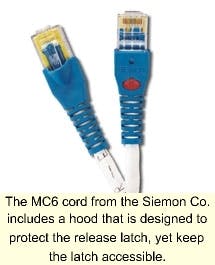Michelle Abrams
When standing in the golf pro shop, all the shiny new clubs are very attractive. Looking at them, one can't help but dream of being the next Tiger Woods. Beside those sparkling new clubs, however, the little white balls on the shelf pale in comparison. Yet those balls are a necessary component to golf and without them, the clubs are useless and the game cannot be played.
Patch cords are the cabling system's not-so-ordinary equivalent of golf balls-an integral component that makes up in function what it lacks in glamour. Patch cords are sections of cable with connectors at either one or both ends, and are available in both fiber-optic and unshielded twisted-pair (UTP) versions. Recently, however, the UTP patch cord has garnered much more attention than the fiber-optic variety.
The textbook definition of a patch cord is "cable utilized to connect telecommunications circuits or links at the crossconnect." A more real definition of a patch cord, according to John Wages, associate product manager for the Siemon Co. (Watertown, CT), is simply "something to patch from one pathway to another." Wages identifies two main reasons for using a UTP patch cord: connecting patch panel to patch panel, and connecting from wall to computer terminal.
Not fancy but vital
In addition, Tim Deal, vice president of cable installer Computer Technology Corp. (Cinnaminson, NJ), uses patch cords to connect the patch panel to the hub. In the day-to-day premises wiring done by Deal's firm, he regards patch cords as vital. According to John Schmidt, ADC Telecommunication's (Minneapolis, MN) product manager for enterprise connectivity, these devices are extremely versatile and let virtually any network user make changes in a system or to activate circuits within the system (see Product Update table, page 84).
While alternatives to the patch cord are available, Bill Fetter, global coordinator for Krone Inc.'s (Englewood, CO) TrueNet patch-cord line, says the "home-run" system design does not allow for any modularity. And another option, hardwiring the cable into the PC, does not afford flexibility. Therefore, he says, patch cords are especially ideal for installations involving moves, adds, and changes.
Patch cords have been around for some time but only recently have they become a topic of public debate. Todd Harpel, Berk-Tek's (New Holland, PA) marketing programs manager, cites the new patch-cord qualification 568-A-4, which came out in 1999, as a trigger for the recent discussion. While the amendment only covers up to Category 5 cable, efforts are being made to add a patch-cord section to the pending Category 6 standard that will cross-apply to Category 5E cords. Still, Harpel sees the current Category 5 standard as providing solid help in determining future standards.
In addition to the ongoing debate surrounding patch-cord standards, a great deal of banter is occurring over manufacturing. Specifically, debate continues regarding whether it is better to have a patch cord that is wholly manufactured and assembled by one company, as opposed to a patch cord that is assembled from select parts at a second or third location.
Berk-Tek is an example of a company that focuses on one component and then supplies it to cable-assembly houses. "It gives us an advantage because we have specific engineering experience and expertise in making cable, as do the connector companies in making connectors," notes Harpel.
"We have specific patents that you won't get if you try to make everything," he continues. The result is cable made by a company specializing in cable, while the connector is made by a company with experience only in connectors.
On the flip side, Krone makes all patch-cord components in-house, which, according to Fetter, ensures quality control. Ultimately, as long as the components have been tested and terminated properly, the result should be a quality patch cord. More than location, Krone believes the processes of manufacturing and assembly are of utmost importance to performance.
Computer Technology Corp.'s Deal believes the patch cord's manufacturing process has a direct impact on its performance in the field. He says, "If they are not built correctly, you can come up with flaky connections." Krone's Fetter also advises that "if your patch cord isn't really well-made, you are damaging your signal from the very start, or even trying to carry a weak signal over something that isn't very good at all."
Complete patch cord
This brings to light the question, What is a well-made patch cord? ADC's Schmidt says the manufacturing process should be of primary concern, with the termination and testing processes keys to a well-made patch cord. ADC manufactures plugs rather than patch cable and then assembles the cords using its own termination techniques. Once the cords are assembled, ADC places them through high-frequency testing, rather than just testing for continuity, to ensure proper function of all components.
Krone, meanwhile, tests each patch cord in the field to ensure it functions flawlessly with the network for which it was purchased. The Siemon Co. tests each cord before selling it, and includes the individual test results with the package.
Along with testing and termination, flexibility is another key to a well-made patch cord. The majority of all UTP patch cords are stranded, promoting maximum flexibility. Krone, however, has developed a technique that involves compressing the strands on the copper and then applying a thin layer of bonding to hold the strands in place. The purpose is to give the patch cable a performance level closer to that of solid cable.
In addition, a well-made patch cord should perform with an impedance measurement of about 100 ohms. Impedance is a measure of the total opposition the patch cord offers to the flow of alternating current. A measurement of 100 ohms ensures the signal can travel over the patch cord without interruption.
Connectors complete the package
But a patch cord is not complete without the connectors found at one or both ends of the cord. The connectors, or plugs, for a UTP patch cord are typically male and are most always RJ-45-style, which means they are based on an 8-pin modular plug. ADC's Schmidt says, "All Category 5E and Category 6 plugs meet the interface requirements of the 8-pin modular plug."
While the actual plugs tend to be fairly standard, various techniques are used to increase effectiveness and performance. The plug design determines its ability to support certain amounts of variability. ADC actually places a secondary insert on its plugs to decrease levels of variability in the termination process.
Some companies place protective hoods on their patch cords, but that is not always welcomed by installers. "Hooded, snag-proof, jacketed heads on the RJ-45 connectors make them hard to get in and out," says Deal. The plastic locking pin, which is covered by the jacket, is much more accessible when left uncovered, he says. The Siemon Co. uses the hood to protect the release latch, but the company assures that the latch is still easily accessible.
Patch cords are an integral tool in ensuring a signal is successfully transmitted from point A to point B. In fact, Krone's own research data has shown patch cords to be the cause of many data-transmission errors. That said, patch cords must be selected and maintained to reduce return loss-a ratio of outgoing signal power to reflected signal power. Simply put, return loss is noise measured in decibels. It is caused by kinks in the cable, general cable problems, and at places where components come together, such as termination points. Additionally, return loss can result from impedance variations.
Quabbin Wire & Cable Co. (Ware, MA), manufacturer of bulk patch cable, is widely known for its research and advocacy of return-loss issues. Bob Woodward, data-telecommunications sales specialist, defines return loss as "a signal echo created by impedance mismatches in the channel." It is not a primary concern when buying Category 5 patch cords, Woodward says, but it does become a problem with higher-speed applications due to the high quantity of information being sent at extreme speed.
Numerous issues beyond return loss must be considered when purchasing patch cords, especially with the constant advancement in cabling standards. Backward-compatibility has become a primary consideration when selecting Category 6 patch cords. Most locations feature a large quantity of cabling components that are not always Category 5 or 5E, so selecting a patch cord that is backward-compatible to existing cabling components is the most logical and economical option.
Interoperability important
Patch cords should also be examined for interoperability with other cabling components. Just as systems are constantly changing, so are the companies that supply the components. Today's supplier may not exist next year or their prices may no longer be competitive. Choose patch cords that are compatible with components of numerous suppliers and manufacturers.
The Siemon Co.'s Wages lists four factors that are important when selecting a patch cord: backward-compatibility, interoperability, performance, and price. Backward-compatibility, he says, is most important because as standards are constantly advancing, it becomes more important for past, present, and future components to work well together.
When selecting patch cords, Deal says his only preference is "for cords that work over those that give problems. With a two- to three-dollar piece, there is a limit as to what you can do with them."
But even though patch cords may be virtually insignificant when it comes to price, they make all the difference between network performance getting caught in a sand trap or scoring a hole-in-one.


